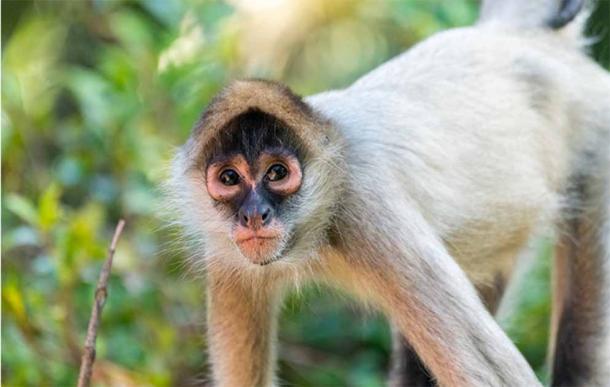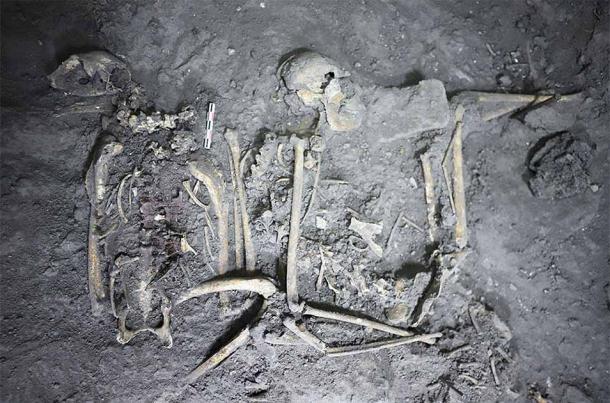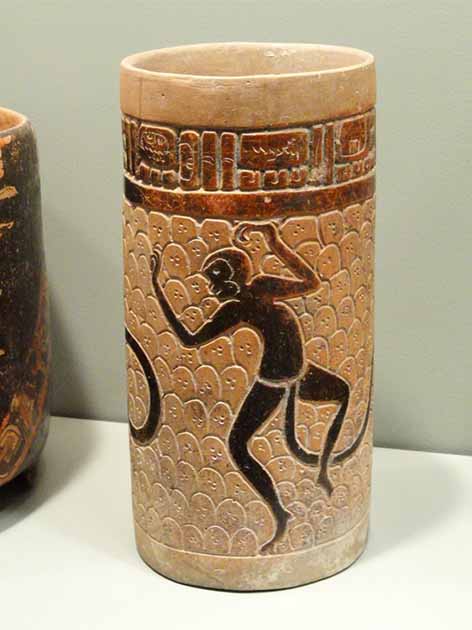Diplomacy by Spider Monkey? Maya Peace Offering Found at Teotihuacan
A spider monkey sacrificed to the gods in the great Mesoamerican city-state of Teotihuacan in 300 AD may have originally been a gift of friendship from their rivals the Maya. At least this is what a study in the journal PNAS has concluded.
Spider monkeys were indigenous to Maya territory but did not live in the region around Teotihuacan, which is why the discovery of the animal’s bones during a recent excavation at Teotihuacan suggests that some type of diplomatic relationship must have existed between the two Mesoamerican superpowers at the beginning of the fourth century.
Spider Monkey Provides Insight into Mesoamerican Diplomacy
Previously, not much was known about the relationship between the awesome and powerful Maya Empire of the early Classic Period (250 to 350 AD) and the first-millennium imperial city-state of Teotihuacan, their mighty neighbors to the northwest, during this period.
- Explorers That Found Ancient Lost City of the Monkey God Almost Lose Their Faces to Flesh-Eating Parasite
- Why Have Centuries-Old Monkey Bones Just Been Found inside Nottingham Castle?
Starting around the year 1 AD, Teotihuacan arose as a dominant entity in an area of central Mexico just 30 miles (48 km) from modern-day Mexico city. At Teotihuacan’s population peak it may have been home to as many as 100,000 residents, making it one of the largest cities in the world 1,700 years ago.
Teotihuacan was certainly prosperous enough to have mounted a military challenge to the Maya in the greater Mesoamerican region at any time of their choosing. But in the early fourth century it seems that political leaders on both sides of the divide were more interested in making a peaceful alliance than in going to war.
“This little story of one single spider monkey really brought out a lot of information about all sorts of inter-regional ties,” study lead author Nawa Sugiyama, an archaeologist at University of California, Riverside, told National Geographic.

Archaeologists have uncovered evidence that the spider monkey was used as a peace offering by the Maya. (Khanh / Adobe Stock)
Spider Monkeys and the Ancient Maya
Spider monkeys are now listed as an endangered species. But in the first half of the first millennium, they were common in certain areas of Mesoamerica controlled by the Maya. They appeared frequently in Maya carvings and paintings, which shows they were valued by Maya society and may even have been considered sacred.
If the Maya gave a captive spider monkey to the government or people of Teotihuacan, it’s safe to assume that it was offered as a sign of friendship or perhaps to cement some sort of diplomatic agreement.
“Amazing stuff,” said Bárbara Arroyo, an archaeologist at the Dumbarton Oaks research library who was not directly involved in this new study, in an interview with the online publication Science:
“I have been very skeptical sometimes when people talk about these connections between the Maya and Teotihuacan. But in this specific case, it’s so well documented and so well proven that this animal was from the Maya area and was moved and transported to… Teotihuacan.”
Using Science to Study Ancient International Relations
The well-preserved and complete skeleton of the spider monkey was discovered in 2018, during excavations under a mound in Teotihuacan’s Plaza of Columns, which functioned as a gathering place for major public events. Its feet and hands were bound, and it was buried alongside the remains of several other animals, including a puma, multiple rattlesnakes, a golden eagle and a few small unidentified birds.
Headed by Nawa Sugiyama, the archaeological team also unearthed a glorious and impressive collection of sacrificial grave goods alongside the animals, including exquisitely carved figurines, different types of precious jewelry, obsidian knives and arrowheads.
The animals would have all been killed during a ritual sacrifice ceremony and buried together in a sacred spot in the Plaza located between Teotihuacan’s Pyramids of the Sun and Moon. Their place of burial had previously been covered by a structure of some type, but this building was torn down to make way for the construction of a new pyramid that has been designated as 25C by its modern-day discoverers.

Archaeologists unearthed the skeletal remains of a golden eagle (on the left) and a spider monkey (on the right) within a sacrificial cache in Teotihuacan. (N. Sugiyama / Project Plaza of the Columns Complex)
Examining the Spider Monkey Diplomat
In this comprehensive new study, Nawa Sugiyama assembled a team of scientists with expertise in the fields of archaeology, biology, geology and ancient genetic studies, who collaborated to uncover as much information as possible about the anomalous spider monkey.
The scientists were able to discern that the monkey was female and somewhere between the ages of five and eight at the time of her death. DNA analysis of the skeleton identified it as having come from a subspecies of spider monkey native to Maya tropical forests.
Research has concluded that she had spent at least two years in captivity in the arid highlands around Teotihuacan. Wild spider monkeys eat predominantly fruits and nuts, but chemical markers found in the monkey’s remains, plus starch grains found in her tooth plaque indicate that the monkey had been in Teotihuacan for quite some time before being sacrificed. She spent her last years eating maize (corn), tubers and grass, coping as best she could with living outside her home environment.
This is the first spider monkey skeleton to ever be found in Teotihuacan. This indicates that these animals were not normally sought by the people of Teotihuacan, which means the monkey had been brought to Teotihuacan as a special and unique offering.
Collections of skeletal remains from animals offered as sacrifices have been found elsewhere around Teotihuacan. Frequently high-level predators like wolves, jaguars, and eagles were killed during ritual ceremonies, which were often organized during the dedications of new pyramids.
“[The residents of Teotihuacan] considered their pyramids as sacred mountains,” Nawa Sugiyama explained. “They're alive and breathing. You negotiate with them when you petition for water. So we should be understanding these offerings as animals that were meant to live inside of the mountain to protect the city as well.” Radiocarbon dating of the spider monkey and accompanying animal skeletons put their time of death at somewhere between 250 and 300 AD.

Maya cylinder vase dating back to 650 to 750 AD depicting a spider monkey. (Public domain)
When Friends Became Enemies
Interestingly, this is not the only evidence of friendly contact between the Maya and the people of Teotihuacan found in Plaza of Columns excavations. Earlier digs produced evidence to suggest there was at least one grand feat that took place there between the years 300 and 350 that included Maya dignitaries as guests.
Additionally, archaeologists found several buildings at the site that contained caches of Maya pottery, along with colorful murals that depicted gods, mythological creatures and symbols associated with the Maya metaphysical belief system.
Nawa Sugiyama is convinced the buildings that held these wonders were reserved for visiting Maya political leaders, aristocrats or diplomats. “Imagine who’s invited to stay at the White House and downtown [near] the National Mall,” Sugiyama says. “That sort of prime real estate is where we’re finding these Maya dignitaries, maybe even royal elites.”
- Ancient Monkey Soldiers? Romans Buried Barbary Ape with Military Offerings
- Pet Monkeys Buried Like Children In Ancient Egypt
Unfortunately, after the mid-fourth century something went terribly wrong between the Maya and the people of Teotihuacan. Many of the Maya murals found in the buildings on the Plaza of Columns had actually been smashed to pieces, and there was evidence that captured Maya dignitaries may have been murdered or sacrificed in the city between the years 350 and 400.
Meanwhile, carvings of the people of Teotihuacan found in Maya territory depicted them as warlike and hostile, offering further signs of some deep-seated hostility between the two cultures. Perhaps this breakdown in the relationship was inevitable, given the expansionist nature of powerful ancient Mesoamerican empires. But as the new study published in PNAS reveals, for a few centuries at least a peaceful coexistence was maintained.
Top image: Aerial image of the Pyramid of the Moon at Teotihuacan in Mexico. Source: Wirestock Creators / Adobe Stock; Khanh / Adobe Stock; N. Sugiyama / Project Plaza of the Columns Complex
By Nathan Falde

















